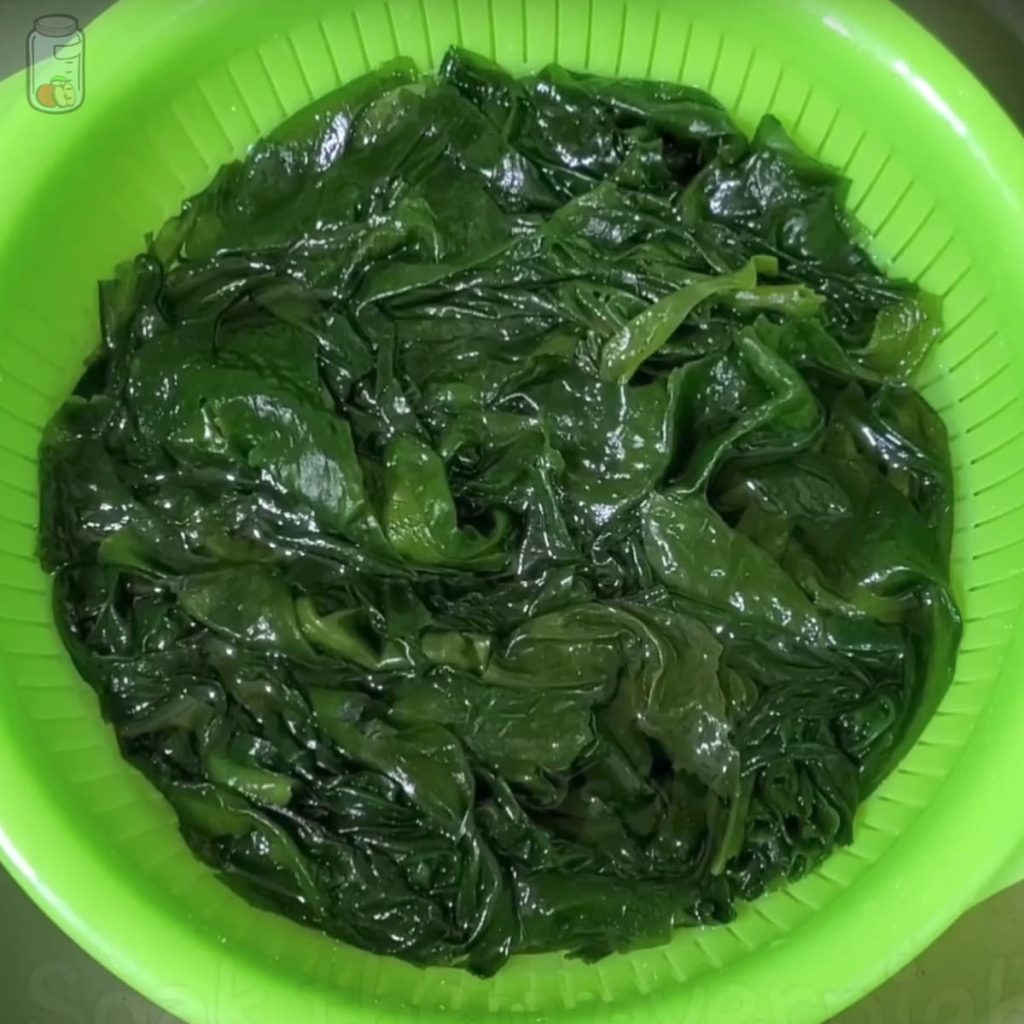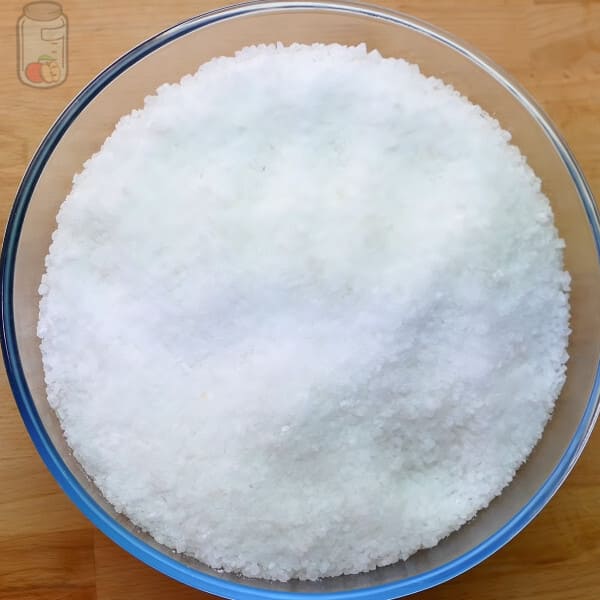To store fresh seaweed, you should use the refrigerator for 3 to 4 days or frozen for 6 to 12 months. However, it is much more common to find dried seaweed that can be kept at room temperature for 3 or 5 years if the packaging is sealed.
Keep reading if you want to know how to preserve seaweed in detail.

How to keep fresh seaweed in the fridge
It is not common to find fresh seaweed unless it is a typical product of the gastronomy of your country, so to store it, follow these guidelines:
- Step 1: Wash the seaweed several times.
If you acquired “freshly harvested” seaweed, you must wash it several times (at least three) to eliminate traces of sand, stones, and salinity.
Immerse the seaweed in clean water (filtered or mineral) in a pot or bowl, shake and stir, then strain and repeat the process with clean water. If you bought fresh seaweed at the supermarket, you only need to wash it once.
- Step 2: Strain the seaweed.
As the seaweed retains too much moisture, leave them in the colander after straining them for a long time. You can squeeze them a little, and if you have a salad spinner, it will be much better since you would not have to wait so long.
- Step 3: Put the seaweed in an airtight container.
Now, place the seaweed inside an airtight container, but you could also use an airtight bag.
- Step 4: Store the seaweed in the fridge.
Put the seaweed in a cool area, not too cold. In this way, you can store seaweed in the fridge for 3 and 4 days. [1]
If you have some cooked seaweed left over, wait until it cools before putting it in an airtight container. Cooked seaweed can be 4 to 5 days in the fridge.
How to freeze seaweed
Can seaweed be frozen? You can freeze seaweed but must blanch it first; otherwise, it will fall apart when thawed.
This is mainly due to the large amount of water these plants retain, becoming ice crystals that break their structure.
So, if you want to freeze the seaweed the right way, do the following:
- Step 1: Wash the seaweed.
If you have yet to wash the seaweed, immerse them in a large pot or bowl with clean water, stir them, and shake them well. If they are freshly harvested, you should perform this procedure at least three times, but if you bought them in a food store, it will be enough to wash them once.
- Step 2: Whiten the seaweed.
Take a pot of water to the stove. When it boils, add the seaweed, and cook for 1 or 2 minutes, then take them out and put them in a bowl with cold water and some ice cubes to cut the cooking. Wait a minute before straining.
- Step 3: Dry the seaweed.
Before freezing the seaweed, dry them well so that excess moisture does not harm them. To do this, spread them on absorbent paper or a clean towel.
- Step 4: Freeze the seaweed for several hours.
After drying the seaweed, spread it on a plate or tray with nonstick foil or waxed paper. Put the tray in the freezer for 4 hours or until the seaweed is well frozen.
- Step 5: Place the seaweed in sturdy containers.
You can put the frozen seaweed in freezer-resistant bags or containers. Any of these containers must be airtight. Since the seaweed has already been previously frozen, it will not stick.
- Step 6: Write the storage date of the seaweed.
This way, you can maintain better control over the seaweed and get an idea of its shelf life. You can write or label the date directly on the bag or container.
- Step 7: Store the seaweed in the freezer.
Following all the indications, the seaweed can spend 6 to 12 months in the freezer. The duration time will depend a lot on the type of seaweed; the softer they are, the less time they should remain frozen.
If you want to thaw the seaweed, leave it for 40 minutes at room temperature or let it overnight in the fridge.
The thawed seaweed in the refrigerator can be kept there for 1 or 2 more days since, if you thawed them at room temperature, you would have to consume them the same day.
To reheat the seaweed, I advise you to leave them for a few minutes steaming, in the pan, or boiling them.
How to dehydrate seaweed
For many, one of the best ways to preserve seaweed is to dehydrate it because it will retain its nutrients better and partially recover its consistency since you can rehydrate it.
To dehydrate seaweed at home, follow these steps:
- Step 1: Wash the seaweed.
In a large pot or bowl filled with clean water, submerge the seaweed, and stir and shake them to wash them properly. If they are freshly harvested, you must wash them at least three times, changing the water each time. Still, you will only have to do it once if you buy them at the supermarket.
- Step 2: Strain the seaweed.
After washing the seaweed, strain it. Squeeze it a little in the colander and leave it there for a long time to drain the excess water, but if you have a spin bowl, use it. You can dry it at the end with a clean, dry towel or absorbent paper.
- Step 3: Dehydrate the seaweed.
It is best to dehydrate the seaweed with a food dehydrator since, despite taking much longer, it will dry much more adequately.
Arrange the seaweed inside the dehydrator trays, leaving some space between them, set the temperature to about 100°F – 120°F (40°C or 50°C), and wait 6 or 8 hours for them to dry.
If you use a conventional oven, prepare a tray with parchment paper or a nonstick or grid sheet, and place the seaweed next to each other but slightly apart.
Preheat the oven to about 100°C or 120°C (210°F-250°F), put the tray with the seaweed and bake for 3 hours. Turn the seaweed over after the first hour, and you must be aware that they do not burn.
You will know that the seaweed dehydrates properly when it reduces its size and becomes somewhat brittle.
- Step 4: Put the dehydrated seaweed in airtight containers.
Do not put the dehydrated seaweed inside the containers if it is still hot; better wait until they cool. If you want to store dry seaweed at room temperature, I recommend using glass containers with an airtight lid.
However, you can also put the dehydrated seaweed in plastic containers, and resistant if you want to freeze them.
- Step 5: Write down the date of preparation.
Tape the container or bag and write the date or stick a label with that information.
- Step 6: Save the dehydrated seaweed.
You have two options available. The first is to place the dried seaweed in a dark, cool, dry place to preserve it for a year at room temperature.
The other alternative would be to freeze the dehydrated seaweed for 2 to 5 years. I do not advise storing homemade dried seaweed in the fridge because it could absorb the moisture around it and last less time.
To rehydrate the seaweed, only soak them in water for several minutes or until they soften. Rehydrated seaweed can be stored in the fridge for 1 or 2 days, and I do not advise freezing them.
How to preserve commercially sold dried seaweed
Dried or dehydrated seaweed is common in most supermarkets and food stores, as it has been available for a long time.
The way to store it is straightforward since it is enough to put the sealed packaging of dried seaweed in a place away from sunlight, free of moisture, and cool.
This way, at room temperature, you can keep dried seaweed for commercial sale in good condition until the expiration date, between 3 to 5 years.
Once open, you must place them in bags or airtight containers, which would not reduce the duration time in most cases.
However, some experts recommend consuming dried seaweed within a year once you open it. If you freeze the commercially dried seaweed, you can keep it for 2 or 5 years.
If you rehydrate commercially dried seaweed, you can store it in the fridge for 2 or 3 days, and some may freeze for 3 or 4 months.
This would be possible, first, by the preservatives, and second, some types of seaweed are dehydrated. Still, if the manufacturer recommends not freezing, it is better to follow those indications.
How do you know if the seaweed spoiled?
One of the first signs that seaweed will get bad is its smell, so if it starts to smell bad, like rotten, throw it away.
If the seaweed has a sour or bitter taste, it is not in good condition either, and you must throw it away.
If the seaweed develops mold, you should get rid of them, and you will know that they have mold if black or white spots or lint appear on them.
Eating seaweed with a strange texture or consistency, such as very watery and viscous, is also not a good idea since it is most likely rotten.
How long does seaweed last?
| Product | Duration |
| Fresh seaweed in the fridge | 3 – 4 days |
| Cooked seaweed in the fridge | 4 – 5 days |
| Frozen seaweed | 6 – 12 months |
| Thawed seaweed in the fridge | 1 – 2 days |
| Dehydrated seaweed at room temperature | 1 year |
| Dehydrated in the freezer | 2 – 5 years |
| Rehydrated seaweed in the fridge | 1 – 2 days |
| Store-bought dried seaweed at room temperature (sealed) | (3 – 5 years) |
| Store-bought dried seaweed at room temperature (open) | 1 year |
| Store-bought dried seaweed in the freezer (open) | 3 – 5 years |
| Store-bought rehydrated seaweed in the fridge | 2 – 3 days |
| Store-bought rehydrated seaweed in the freezer | 3 – 4 months |
What is the best way to conserve seaweed?
It is better to keep fresh seaweed in the fridge, although not too long, contrary to what happens with frozen seaweed, which lasts a long time. Still, its flavor and consistency can be affected the longer it spends in the freezer.
Therefore, dehydrating seaweed is the best way to preserve it since it lasts much longer, and most seaweed recovers some of its consistency when rehydrated.
Commercially sold dried seaweed typically lasts much longer thanks to preservatives. If kept sealed, it could last years in your pantry.
To know how to preserve another food, you must use my search engine because on this site, you have a wide variety of topics related to conservation, and we regularly update and add more information.
[1] https://theecologist.org/2015/nov/26/seaweed-shore-seaweed-kitchen#:~:text=Storage%3A%20Deal%20with%20fresh%20seaweed,seaweed%20as%20you%20would%20pasta.







